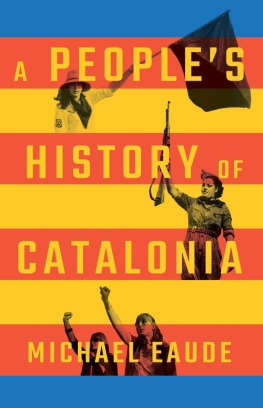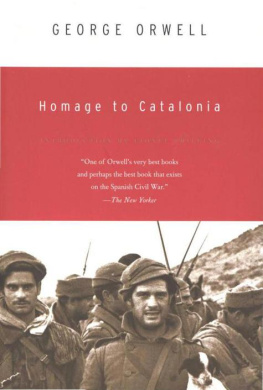Virginie Raguenaud - The Colors of Catalonia: In the Footsteps of Twentieth-Century Artists
Here you can read online Virginie Raguenaud - The Colors of Catalonia: In the Footsteps of Twentieth-Century Artists full text of the book (entire story) in english for free. Download pdf and epub, get meaning, cover and reviews about this ebook. year: 2012, publisher: GemmaMedia, genre: Detective and thriller. Description of the work, (preface) as well as reviews are available. Best literature library LitArk.com created for fans of good reading and offers a wide selection of genres:
Romance novel
Science fiction
Adventure
Detective
Science
History
Home and family
Prose
Art
Politics
Computer
Non-fiction
Religion
Business
Children
Humor
Choose a favorite category and find really read worthwhile books. Enjoy immersion in the world of imagination, feel the emotions of the characters or learn something new for yourself, make an fascinating discovery.

- Book:The Colors of Catalonia: In the Footsteps of Twentieth-Century Artists
- Author:
- Publisher:GemmaMedia
- Genre:
- Year:2012
- Rating:4 / 5
- Favourites:Add to favourites
- Your mark:
- 80
- 1
- 2
- 3
- 4
- 5
The Colors of Catalonia: In the Footsteps of Twentieth-Century Artists: summary, description and annotation
We offer to read an annotation, description, summary or preface (depends on what the author of the book "The Colors of Catalonia: In the Footsteps of Twentieth-Century Artists" wrote himself). If you haven't found the necessary information about the book — write in the comments, we will try to find it.
The Colors of Catalonia: In the Footsteps of Twentieth-Century Artists — read online for free the complete book (whole text) full work
Below is the text of the book, divided by pages. System saving the place of the last page read, allows you to conveniently read the book "The Colors of Catalonia: In the Footsteps of Twentieth-Century Artists" online for free, without having to search again every time where you left off. Put a bookmark, and you can go to the page where you finished reading at any time.
Font size:
Interval:
Bookmark:

First published by GemmaMedia in 2012.
GemmaMedia
230 Commercial Street
Boston, MA 02109 USA
www.gemmamedia.com
2012 by Virginie Raguenaud
All rights reserved. No part of this publication may be reproduced in any manner whatsoever without written permission from the publisher, except in the case of brief quotations embodied in critical articles or reviews.
First e-book edition: June 2012
Cover design: Night & Day Design
Photographs courtesy of the author, except those separately cited in the text.
ISBN 978-1-934-84842-5
To my two favorite artists, Sofiya and Natasha
This book is about the inspiring intersection between art, travel, and the creative spirit. Together we will tour seventeen picturesque villages in French and Spanish Cataloniaplaces where some of the most brilliant minds of the art world found their courage and authenticity. In the fishing village of Collioure, Henri Matisse developed Fauvism with Andr Derain; Pablo Picasso matured as an artist in the mountain villages of Horta de Sant Joan and Gsol and later created Cubism with Georges Braque in Cret. Invigorated by the landscape around Cadaqus and Figueres, where he grew up, Salvador Dal became the most famous of the Surrealist painters. Catalonia also welcomed Paul Gauguin, Charles Rennie Mackintosh, Joan Mir, Aristide Maillol, George-Daniel de Monfreid, Henri Manguin, tienne Terrus, Louis Valtat, Marc Chagall, and many others. Some of these artists were natives of Catalonia, while others chose to pack up their suitcases and travel long hours by train to experience firsthand the glow of the Catalan landscape, its culture, and its people.
An important theme in this book is the power of travel on the creative mind. When you travel, youre confronted with a chance to expand your perspective, to grow, and to self-renew. Youre out of the fog of your daily routines. When you allow yourself to be a stranger in a new place and invite the unknown into your life, you discover great things about yourself. When artists left Paris and arrived in Catalonia, they encountered a new language, a new landscape, and independent and self-reliant villagers who had their own rules and expectations. These artists were suddenly free from the pressures of the academic art world. The noise of the city had been left behind, and they could listen carefully to their own instincts and preferences and create authentic work. Most of the artists of the early twentieth century were guided by the most fearless traveler of them all, Paul Gauguin, who left Paris in 1891 to live among the inhabitants of Tahiti. They adhered to his call to dare everything, and Catalonia proved to be the perfect place to unleash their creative spirits. I hope this book inspires readers to explore Catalonia and its sun-drenched villages, which stand tucked along the Mediterranean Sea or in the foothills of the Canigou Mountain.
Since traveling is like a good work of art, its no surprise that many travelers also find refuge in art museums. As I walk along the halls of the Museum of Fine Arts in Boston, looking at how artists try to define the world around them, Im immediately reassured that I too will find a way to make sense of the world around me. Its like a powerful walking meditation. There are treasures to be found not only in iconic art museums like the Louvre, the Muse dOrsay, and the Hermitage, but also in smaller local museums. I hope this book motivates readerswhether they are on the road or at hometo learn more about the art and lives of both the great twentieth-century art pioneers and the lesser-known artists, including tienne Terrus, George-Daniel de Monfreid, Gustave Fayet, and Louis Valtat, whose talent and vision greatly contributed to the development of modern art. I hope this book also reminds readers to support the arts in their local communities.
Maillol, Matisse, Mir, and many other artists struggled at the beginning of their careers. They often lacked the support of their families, who were unimpressed by their potential future as an artiste maudit, living the Bohemian lifestyle without any financial security. Still, they believed they had something worthwhile to contribute to their craft and persevered. I hope this book encourages artistsyoung and oldto believe in their work. As Gauguin declared in a letter to de Monfreid, Criticism passesgood work remains.
Last but not least, a quick geography lesson. Catalonia was divided in 1659 by King Philip IV of Spain and King Louis XIV of France with the Treaty of the Pyrenees. The region was split along the Albres mountain range, which is part of the Pyrenees and forms a natural border between French and Spanish Catalonia. Spanish Catalonia is composed of four provinces: Barcelona, Girona, Tarragona, and Lleida. It covers an area of more than 12,000 square miles, and its capital is the city of Barcelona. French Catalonia includes six historical regions: Alta Cerdanya, Capcir, Conflent, Vallespir, Fenolheda, and Rossell. French Catalonia is also known as the Roussillon or the dpartement of the Pyrnes-Orientales. The region covers an area of 1,600 square miles, and Perpignan is the capital city. Strangely enough, because of miswording in the Treaty of the Pyrenees, there is one small Spanish enclave, the town of Llivia, which is still located in French Catalonia. After the signing of the treaty, many Catalan villagers ignored the political and geographical developments, as they did not identify as either French or Spanish, but simply as Catalan. It was not until the French government came to the Roussillon to recruit soldiers during World War I that many villagers found out which country they were living in.
I hope you enjoy discovering the beauty of Catalonia and find inspiration in the colorful and uplifting personal stories of the great twentieth-century painters and writers who called it home, even if for just a summer.

Henri Matisse and Andr Derain walk the old cobblestone streets of CollioureAt the Fort St. Elme with Master and Commander author Patrick OBrianLa Casa Quintana opens its doors for acclaimed Spanish poet Antonio MachadoPolish painter Willy Mucha hosts the Surrealist painter Max ErnstSharing an apritif with Pablo Picasso at Les TempliersEating fresh sardines on the beach with painters Louis Bausil and George-Daniel de Monfreid.

View of the harbor and the church of Notre-Dame-des-Anges in Collioure
When Henri Matisse dropped his traveling gear, paint boxes, and easel at lHtel de la Gare in Collioure in the spring of 1905, the artist had crippling doubts about his future as a painter. Matisse was then thirty-five years old with a law degree and three young children. He confided to his close friend and fellow painter Henri Manguin, If I could, I would send painting to hell, its scarcely satisfying and not lucrative enough. Matisses father, disappointed by his sons lack of direction, had stopped giving him a monthly allowance, and Manguin had to lend him the money to make the trip to French Catalonia until his Parisian art dealer, Ambroise Vollard, could send him the few francs he was due. Unsure of his future, Matisse even applied for (and never heard back from) a job as a legal assistant to low-income families in Paris.
The now-legendary artist had an artistic breakthrough in Collioure. Was it sparked by the dramatic, sun-infused colors of the Cte Vermeille, the Ruby Coast? Or the well-timed friendships with free-spirited Catalan artists? Matisse indeed landed in the right location at the right time in his life, and, like any sensible traveler, he made the most of his journey.
Font size:
Interval:
Bookmark:
Similar books «The Colors of Catalonia: In the Footsteps of Twentieth-Century Artists»
Look at similar books to The Colors of Catalonia: In the Footsteps of Twentieth-Century Artists. We have selected literature similar in name and meaning in the hope of providing readers with more options to find new, interesting, not yet read works.
Discussion, reviews of the book The Colors of Catalonia: In the Footsteps of Twentieth-Century Artists and just readers' own opinions. Leave your comments, write what you think about the work, its meaning or the main characters. Specify what exactly you liked and what you didn't like, and why you think so.









